Factors Affecting Marketing Plan for Ryanair: SWOT, PESTLE, Leadership Approaches, and Corporate Social Responsibilities
VerifiedAdded on 2023/06/11
|11
|3822
|130
AI Summary
This paper examines the factors which affect the formulation of the marketing plan for the Irish carrier Ryanair. It includes SWOT and PESTLE study, leadership approaches, and corporate social responsibilities.
Contribute Materials
Your contribution can guide someone’s learning journey. Share your
documents today.
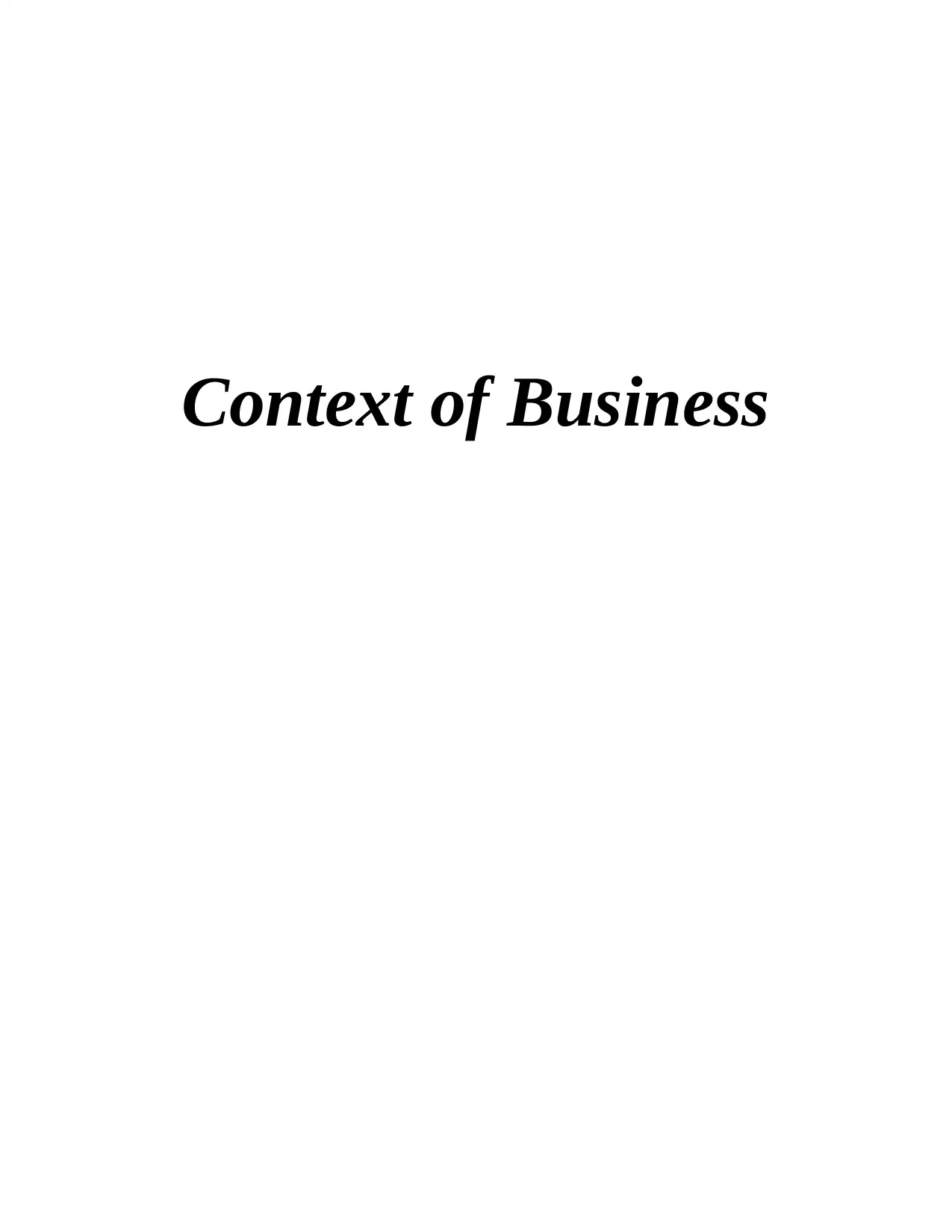
Context of Business
Secure Best Marks with AI Grader
Need help grading? Try our AI Grader for instant feedback on your assignments.
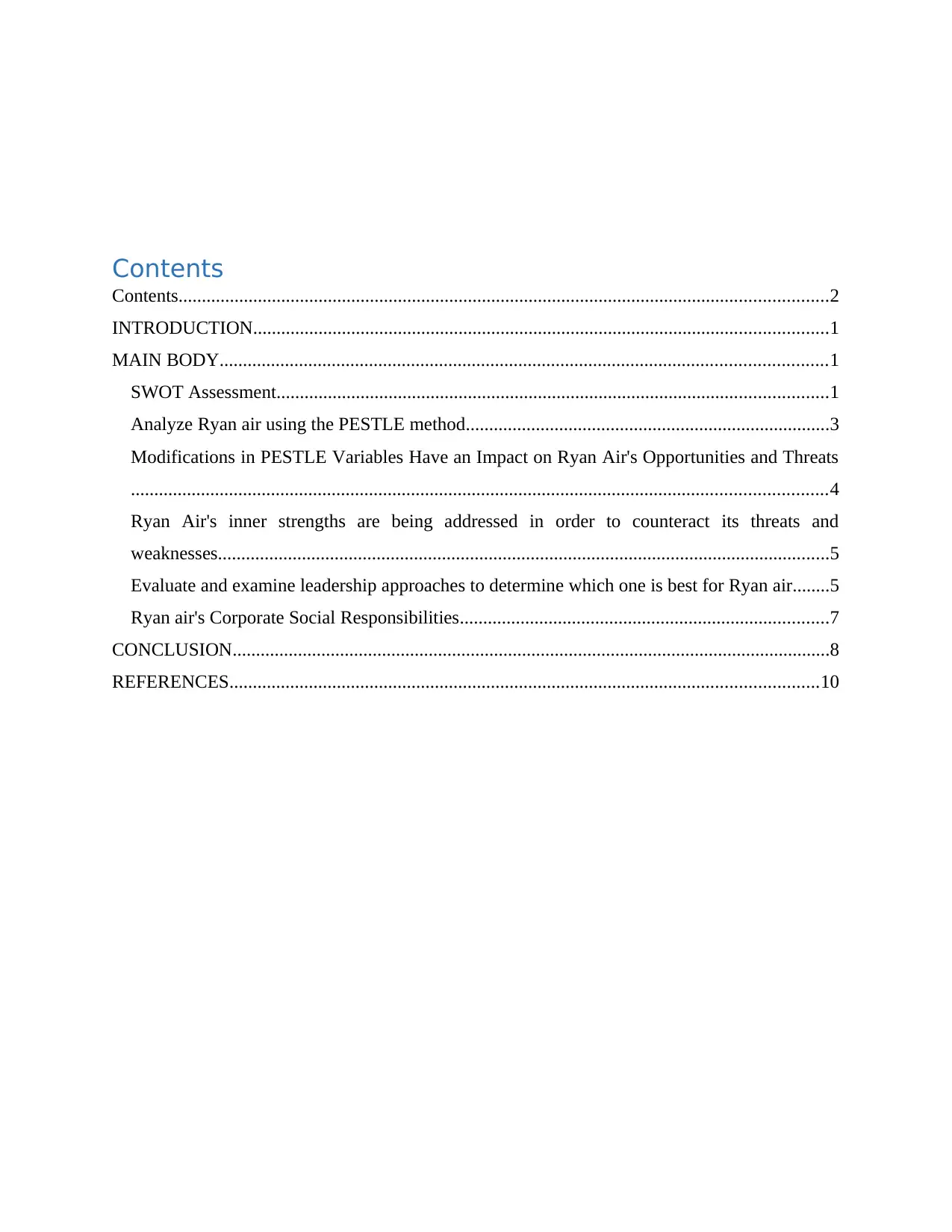
Contents
Contents...........................................................................................................................................2
INTRODUCTION...........................................................................................................................1
MAIN BODY..................................................................................................................................1
SWOT Assessment......................................................................................................................1
Analyze Ryan air using the PESTLE method..............................................................................3
Modifications in PESTLE Variables Have an Impact on Ryan Air's Opportunities and Threats
.....................................................................................................................................................4
Ryan Air's inner strengths are being addressed in order to counteract its threats and
weaknesses...................................................................................................................................5
Evaluate and examine leadership approaches to determine which one is best for Ryan air........5
Ryan air's Corporate Social Responsibilities...............................................................................7
CONCLUSION................................................................................................................................8
REFERENCES..............................................................................................................................10
Contents...........................................................................................................................................2
INTRODUCTION...........................................................................................................................1
MAIN BODY..................................................................................................................................1
SWOT Assessment......................................................................................................................1
Analyze Ryan air using the PESTLE method..............................................................................3
Modifications in PESTLE Variables Have an Impact on Ryan Air's Opportunities and Threats
.....................................................................................................................................................4
Ryan Air's inner strengths are being addressed in order to counteract its threats and
weaknesses...................................................................................................................................5
Evaluate and examine leadership approaches to determine which one is best for Ryan air........5
Ryan air's Corporate Social Responsibilities...............................................................................7
CONCLUSION................................................................................................................................8
REFERENCES..............................................................................................................................10
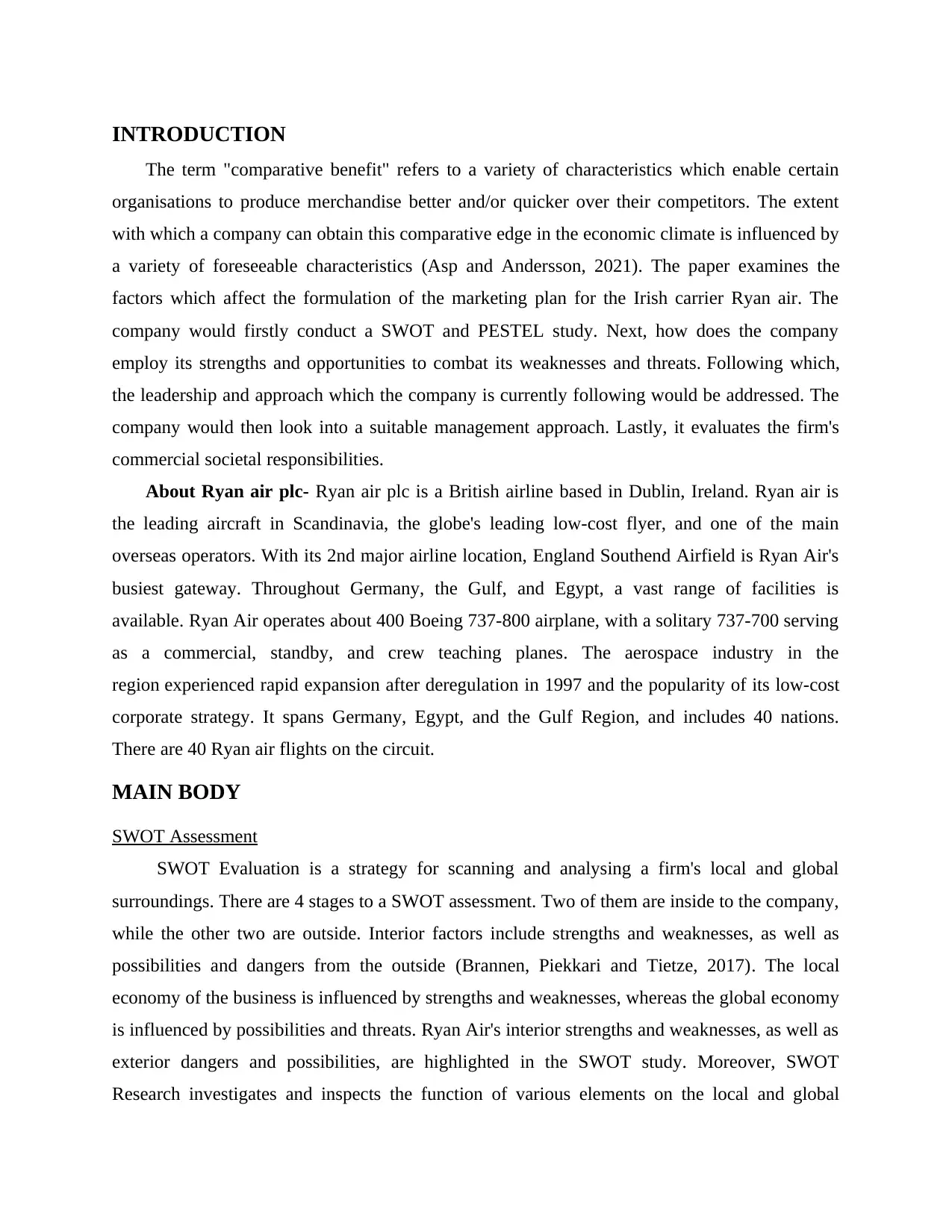
INTRODUCTION
The term "comparative benefit" refers to a variety of characteristics which enable certain
organisations to produce merchandise better and/or quicker over their competitors. The extent
with which a company can obtain this comparative edge in the economic climate is influenced by
a variety of foreseeable characteristics (Asp and Andersson, 2021). The paper examines the
factors which affect the formulation of the marketing plan for the Irish carrier Ryan air. The
company would firstly conduct a SWOT and PESTEL study. Next, how does the company
employ its strengths and opportunities to combat its weaknesses and threats. Following which,
the leadership and approach which the company is currently following would be addressed. The
company would then look into a suitable management approach. Lastly, it evaluates the firm's
commercial societal responsibilities.
About Ryan air plc- Ryan air plc is a British airline based in Dublin, Ireland. Ryan air is
the leading aircraft in Scandinavia, the globe's leading low-cost flyer, and one of the main
overseas operators. With its 2nd major airline location, England Southend Airfield is Ryan Air's
busiest gateway. Throughout Germany, the Gulf, and Egypt, a vast range of facilities is
available. Ryan Air operates about 400 Boeing 737-800 airplane, with a solitary 737-700 serving
as a commercial, standby, and crew teaching planes. The aerospace industry in the
region experienced rapid expansion after deregulation in 1997 and the popularity of its low-cost
corporate strategy. It spans Germany, Egypt, and the Gulf Region, and includes 40 nations.
There are 40 Ryan air flights on the circuit.
MAIN BODY
SWOT Assessment
SWOT Evaluation is a strategy for scanning and analysing a firm's local and global
surroundings. There are 4 stages to a SWOT assessment. Two of them are inside to the company,
while the other two are outside. Interior factors include strengths and weaknesses, as well as
possibilities and dangers from the outside (Brannen, Piekkari and Tietze, 2017). The local
economy of the business is influenced by strengths and weaknesses, whereas the global economy
is influenced by possibilities and threats. Ryan Air's interior strengths and weaknesses, as well as
exterior dangers and possibilities, are highlighted in the SWOT study. Moreover, SWOT
Research investigates and inspects the function of various elements on the local and global
The term "comparative benefit" refers to a variety of characteristics which enable certain
organisations to produce merchandise better and/or quicker over their competitors. The extent
with which a company can obtain this comparative edge in the economic climate is influenced by
a variety of foreseeable characteristics (Asp and Andersson, 2021). The paper examines the
factors which affect the formulation of the marketing plan for the Irish carrier Ryan air. The
company would firstly conduct a SWOT and PESTEL study. Next, how does the company
employ its strengths and opportunities to combat its weaknesses and threats. Following which,
the leadership and approach which the company is currently following would be addressed. The
company would then look into a suitable management approach. Lastly, it evaluates the firm's
commercial societal responsibilities.
About Ryan air plc- Ryan air plc is a British airline based in Dublin, Ireland. Ryan air is
the leading aircraft in Scandinavia, the globe's leading low-cost flyer, and one of the main
overseas operators. With its 2nd major airline location, England Southend Airfield is Ryan Air's
busiest gateway. Throughout Germany, the Gulf, and Egypt, a vast range of facilities is
available. Ryan Air operates about 400 Boeing 737-800 airplane, with a solitary 737-700 serving
as a commercial, standby, and crew teaching planes. The aerospace industry in the
region experienced rapid expansion after deregulation in 1997 and the popularity of its low-cost
corporate strategy. It spans Germany, Egypt, and the Gulf Region, and includes 40 nations.
There are 40 Ryan air flights on the circuit.
MAIN BODY
SWOT Assessment
SWOT Evaluation is a strategy for scanning and analysing a firm's local and global
surroundings. There are 4 stages to a SWOT assessment. Two of them are inside to the company,
while the other two are outside. Interior factors include strengths and weaknesses, as well as
possibilities and dangers from the outside (Brannen, Piekkari and Tietze, 2017). The local
economy of the business is influenced by strengths and weaknesses, whereas the global economy
is influenced by possibilities and threats. Ryan Air's interior strengths and weaknesses, as well as
exterior dangers and possibilities, are highlighted in the SWOT study. Moreover, SWOT
Research investigates and inspects the function of various elements on the local and global
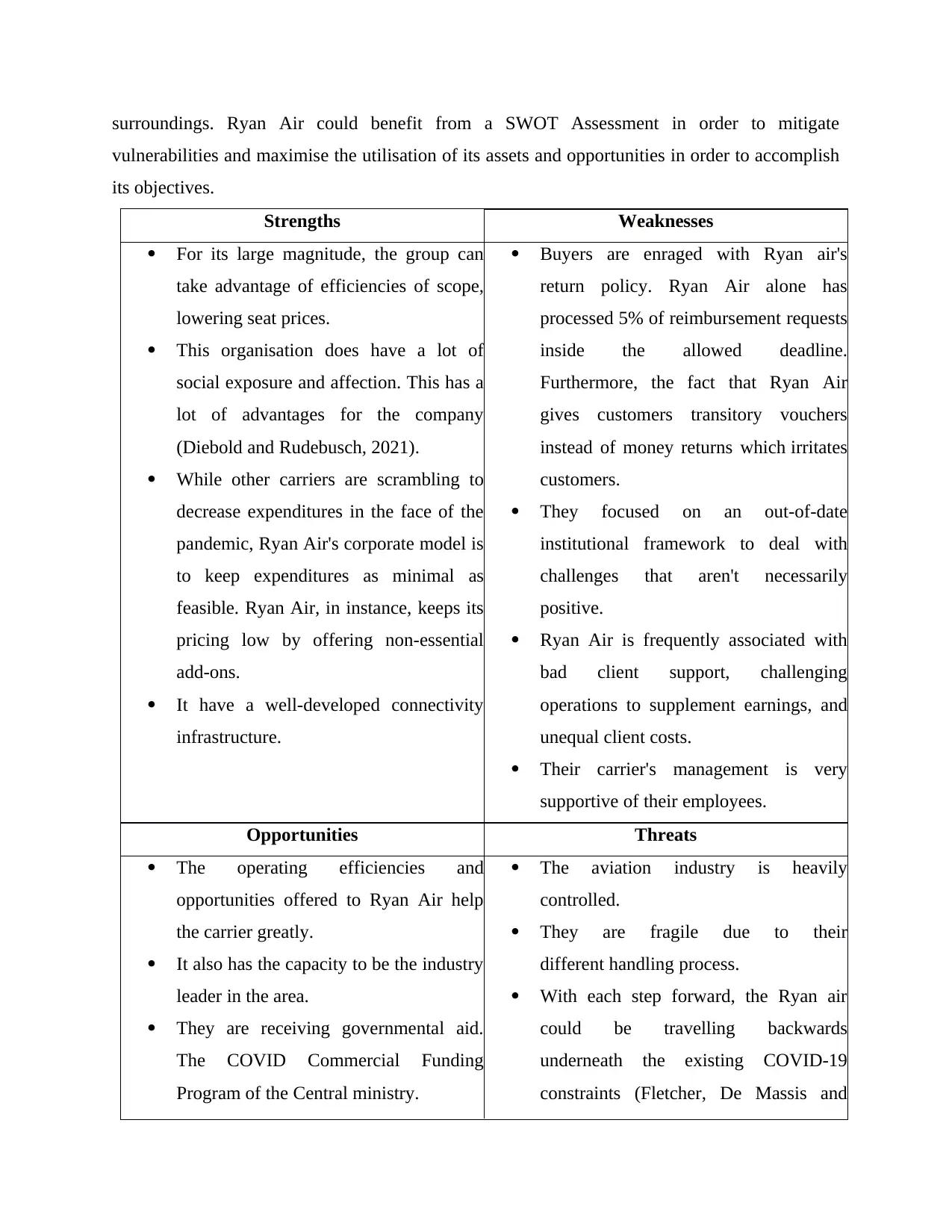
surroundings. Ryan Air could benefit from a SWOT Assessment in order to mitigate
vulnerabilities and maximise the utilisation of its assets and opportunities in order to accomplish
its objectives.
Strengths Weaknesses
For its large magnitude, the group can
take advantage of efficiencies of scope,
lowering seat prices.
This organisation does have a lot of
social exposure and affection. This has a
lot of advantages for the company
(Diebold and Rudebusch, 2021).
While other carriers are scrambling to
decrease expenditures in the face of the
pandemic, Ryan Air's corporate model is
to keep expenditures as minimal as
feasible. Ryan Air, in instance, keeps its
pricing low by offering non-essential
add-ons.
It have a well-developed connectivity
infrastructure.
Buyers are enraged with Ryan air's
return policy. Ryan Air alone has
processed 5% of reimbursement requests
inside the allowed deadline.
Furthermore, the fact that Ryan Air
gives customers transitory vouchers
instead of money returns which irritates
customers.
They focused on an out-of-date
institutional framework to deal with
challenges that aren't necessarily
positive.
Ryan Air is frequently associated with
bad client support, challenging
operations to supplement earnings, and
unequal client costs.
Their carrier's management is very
supportive of their employees.
Opportunities Threats
The operating efficiencies and
opportunities offered to Ryan Air help
the carrier greatly.
It also has the capacity to be the industry
leader in the area.
They are receiving governmental aid.
The COVID Commercial Funding
Program of the Central ministry.
The aviation industry is heavily
controlled.
They are fragile due to their
different handling process.
With each step forward, the Ryan air
could be travelling backwards
underneath the existing COVID-19
constraints (Fletcher, De Massis and
vulnerabilities and maximise the utilisation of its assets and opportunities in order to accomplish
its objectives.
Strengths Weaknesses
For its large magnitude, the group can
take advantage of efficiencies of scope,
lowering seat prices.
This organisation does have a lot of
social exposure and affection. This has a
lot of advantages for the company
(Diebold and Rudebusch, 2021).
While other carriers are scrambling to
decrease expenditures in the face of the
pandemic, Ryan Air's corporate model is
to keep expenditures as minimal as
feasible. Ryan Air, in instance, keeps its
pricing low by offering non-essential
add-ons.
It have a well-developed connectivity
infrastructure.
Buyers are enraged with Ryan air's
return policy. Ryan Air alone has
processed 5% of reimbursement requests
inside the allowed deadline.
Furthermore, the fact that Ryan Air
gives customers transitory vouchers
instead of money returns which irritates
customers.
They focused on an out-of-date
institutional framework to deal with
challenges that aren't necessarily
positive.
Ryan Air is frequently associated with
bad client support, challenging
operations to supplement earnings, and
unequal client costs.
Their carrier's management is very
supportive of their employees.
Opportunities Threats
The operating efficiencies and
opportunities offered to Ryan Air help
the carrier greatly.
It also has the capacity to be the industry
leader in the area.
They are receiving governmental aid.
The COVID Commercial Funding
Program of the Central ministry.
The aviation industry is heavily
controlled.
They are fragile due to their
different handling process.
With each step forward, the Ryan air
could be travelling backwards
underneath the existing COVID-19
constraints (Fletcher, De Massis and
Secure Best Marks with AI Grader
Need help grading? Try our AI Grader for instant feedback on your assignments.
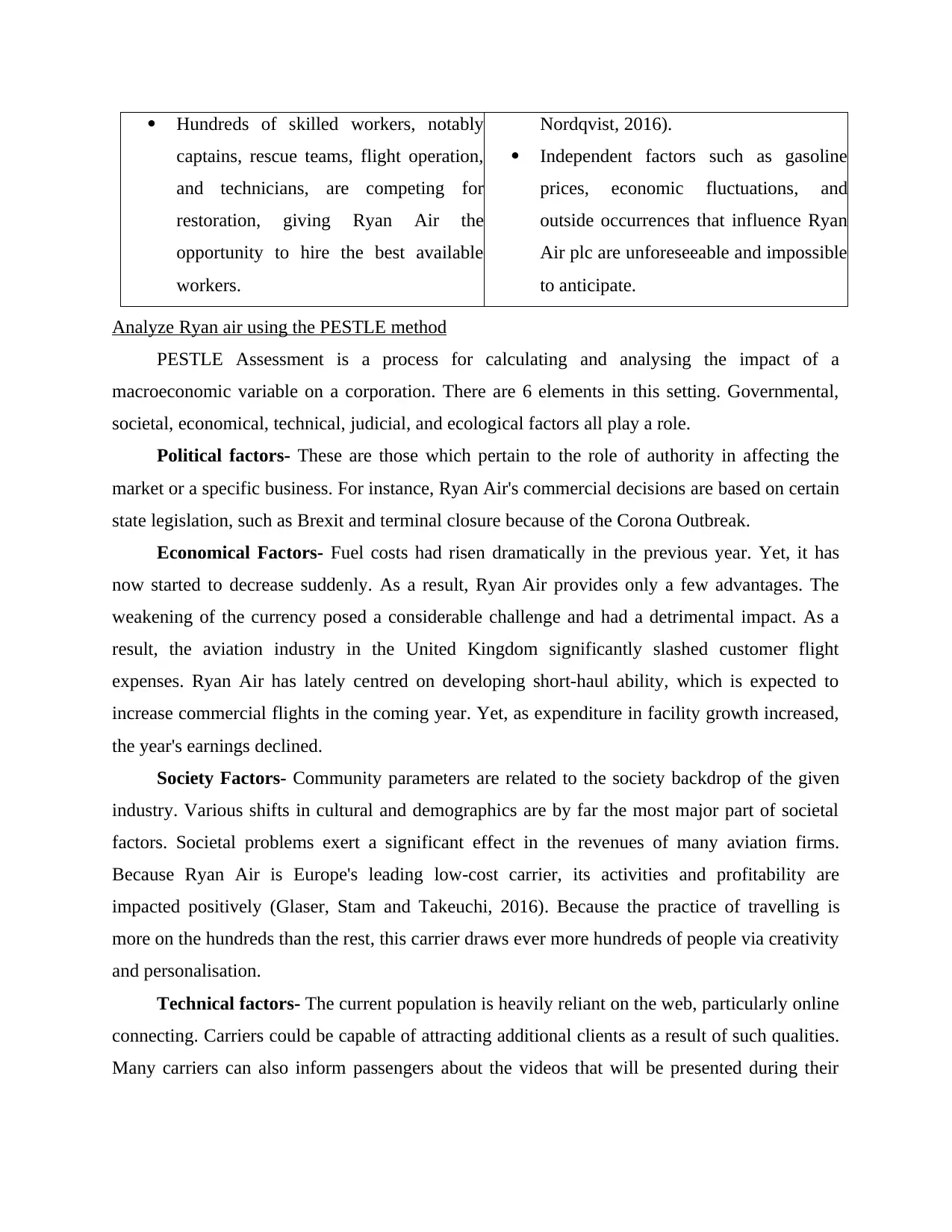
Hundreds of skilled workers, notably
captains, rescue teams, flight operation,
and technicians, are competing for
restoration, giving Ryan Air the
opportunity to hire the best available
workers.
Nordqvist, 2016).
Independent factors such as gasoline
prices, economic fluctuations, and
outside occurrences that influence Ryan
Air plc are unforeseeable and impossible
to anticipate.
Analyze Ryan air using the PESTLE method
PESTLE Assessment is a process for calculating and analysing the impact of a
macroeconomic variable on a corporation. There are 6 elements in this setting. Governmental,
societal, economical, technical, judicial, and ecological factors all play a role.
Political factors- These are those which pertain to the role of authority in affecting the
market or a specific business. For instance, Ryan Air's commercial decisions are based on certain
state legislation, such as Brexit and terminal closure because of the Corona Outbreak.
Economical Factors- Fuel costs had risen dramatically in the previous year. Yet, it has
now started to decrease suddenly. As a result, Ryan Air provides only a few advantages. The
weakening of the currency posed a considerable challenge and had a detrimental impact. As a
result, the aviation industry in the United Kingdom significantly slashed customer flight
expenses. Ryan Air has lately centred on developing short-haul ability, which is expected to
increase commercial flights in the coming year. Yet, as expenditure in facility growth increased,
the year's earnings declined.
Society Factors- Community parameters are related to the society backdrop of the given
industry. Various shifts in cultural and demographics are by far the most major part of societal
factors. Societal problems exert a significant effect in the revenues of many aviation firms.
Because Ryan Air is Europe's leading low-cost carrier, its activities and profitability are
impacted positively (Glaser, Stam and Takeuchi, 2016). Because the practice of travelling is
more on the hundreds than the rest, this carrier draws ever more hundreds of people via creativity
and personalisation.
Technical factors- The current population is heavily reliant on the web, particularly online
connecting. Carriers could be capable of attracting additional clients as a result of such qualities.
Many carriers can also inform passengers about the videos that will be presented during their
captains, rescue teams, flight operation,
and technicians, are competing for
restoration, giving Ryan Air the
opportunity to hire the best available
workers.
Nordqvist, 2016).
Independent factors such as gasoline
prices, economic fluctuations, and
outside occurrences that influence Ryan
Air plc are unforeseeable and impossible
to anticipate.
Analyze Ryan air using the PESTLE method
PESTLE Assessment is a process for calculating and analysing the impact of a
macroeconomic variable on a corporation. There are 6 elements in this setting. Governmental,
societal, economical, technical, judicial, and ecological factors all play a role.
Political factors- These are those which pertain to the role of authority in affecting the
market or a specific business. For instance, Ryan Air's commercial decisions are based on certain
state legislation, such as Brexit and terminal closure because of the Corona Outbreak.
Economical Factors- Fuel costs had risen dramatically in the previous year. Yet, it has
now started to decrease suddenly. As a result, Ryan Air provides only a few advantages. The
weakening of the currency posed a considerable challenge and had a detrimental impact. As a
result, the aviation industry in the United Kingdom significantly slashed customer flight
expenses. Ryan Air has lately centred on developing short-haul ability, which is expected to
increase commercial flights in the coming year. Yet, as expenditure in facility growth increased,
the year's earnings declined.
Society Factors- Community parameters are related to the society backdrop of the given
industry. Various shifts in cultural and demographics are by far the most major part of societal
factors. Societal problems exert a significant effect in the revenues of many aviation firms.
Because Ryan Air is Europe's leading low-cost carrier, its activities and profitability are
impacted positively (Glaser, Stam and Takeuchi, 2016). Because the practice of travelling is
more on the hundreds than the rest, this carrier draws ever more hundreds of people via creativity
and personalisation.
Technical factors- The current population is heavily reliant on the web, particularly online
connecting. Carriers could be capable of attracting additional clients as a result of such qualities.
Many carriers can also inform passengers about the videos that will be presented during their
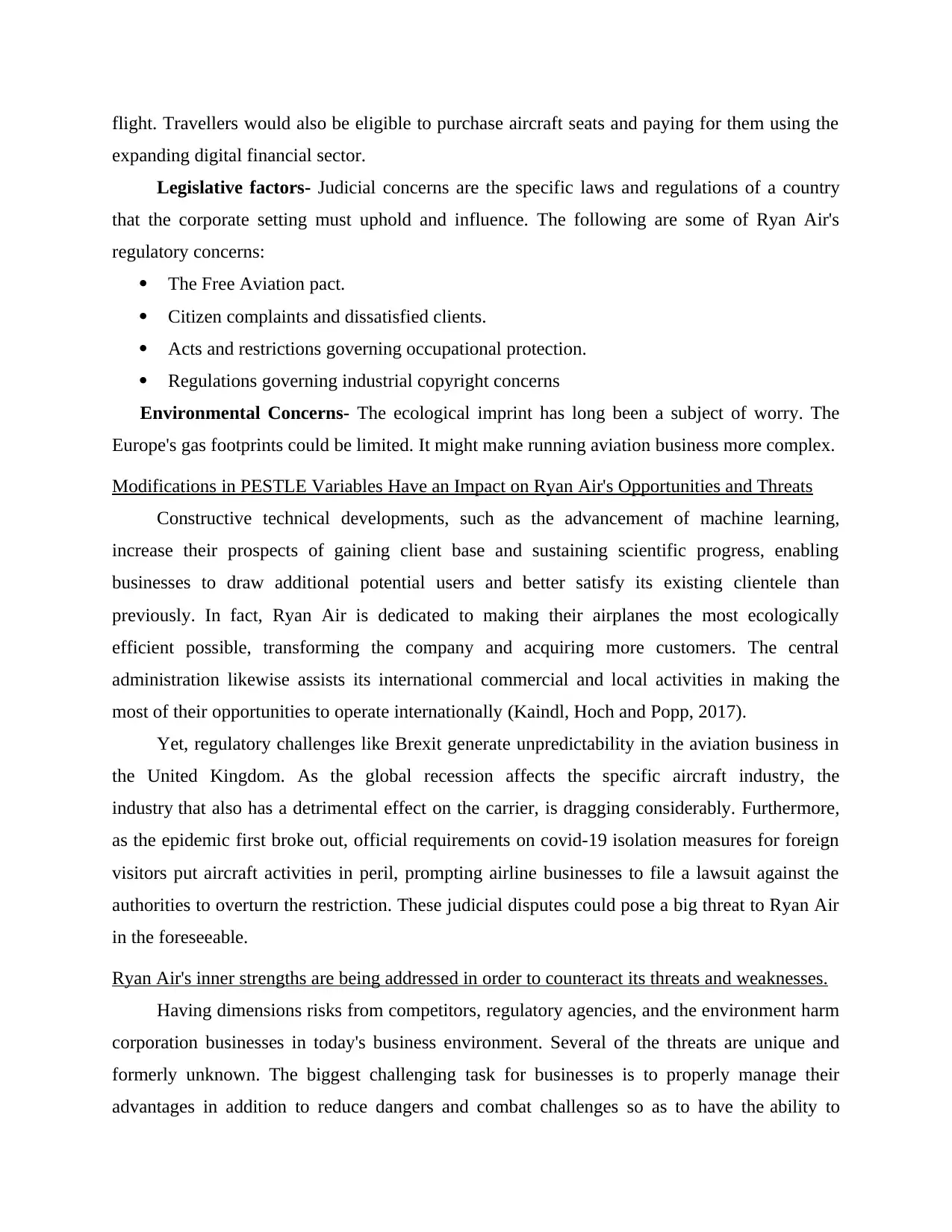
flight. Travellers would also be eligible to purchase aircraft seats and paying for them using the
expanding digital financial sector.
Legislative factors- Judicial concerns are the specific laws and regulations of a country
that the corporate setting must uphold and influence. The following are some of Ryan Air's
regulatory concerns:
The Free Aviation pact.
Citizen complaints and dissatisfied clients.
Acts and restrictions governing occupational protection.
Regulations governing industrial copyright concerns
Environmental Concerns- The ecological imprint has long been a subject of worry. The
Europe's gas footprints could be limited. It might make running aviation business more complex.
Modifications in PESTLE Variables Have an Impact on Ryan Air's Opportunities and Threats
Constructive technical developments, such as the advancement of machine learning,
increase their prospects of gaining client base and sustaining scientific progress, enabling
businesses to draw additional potential users and better satisfy its existing clientele than
previously. In fact, Ryan Air is dedicated to making their airplanes the most ecologically
efficient possible, transforming the company and acquiring more customers. The central
administration likewise assists its international commercial and local activities in making the
most of their opportunities to operate internationally (Kaindl, Hoch and Popp, 2017).
Yet, regulatory challenges like Brexit generate unpredictability in the aviation business in
the United Kingdom. As the global recession affects the specific aircraft industry, the
industry that also has a detrimental effect on the carrier, is dragging considerably. Furthermore,
as the epidemic first broke out, official requirements on covid-19 isolation measures for foreign
visitors put aircraft activities in peril, prompting airline businesses to file a lawsuit against the
authorities to overturn the restriction. These judicial disputes could pose a big threat to Ryan Air
in the foreseeable.
Ryan Air's inner strengths are being addressed in order to counteract its threats and weaknesses.
Having dimensions risks from competitors, regulatory agencies, and the environment harm
corporation businesses in today's business environment. Several of the threats are unique and
formerly unknown. The biggest challenging task for businesses is to properly manage their
advantages in addition to reduce dangers and combat challenges so as to have the ability to
expanding digital financial sector.
Legislative factors- Judicial concerns are the specific laws and regulations of a country
that the corporate setting must uphold and influence. The following are some of Ryan Air's
regulatory concerns:
The Free Aviation pact.
Citizen complaints and dissatisfied clients.
Acts and restrictions governing occupational protection.
Regulations governing industrial copyright concerns
Environmental Concerns- The ecological imprint has long been a subject of worry. The
Europe's gas footprints could be limited. It might make running aviation business more complex.
Modifications in PESTLE Variables Have an Impact on Ryan Air's Opportunities and Threats
Constructive technical developments, such as the advancement of machine learning,
increase their prospects of gaining client base and sustaining scientific progress, enabling
businesses to draw additional potential users and better satisfy its existing clientele than
previously. In fact, Ryan Air is dedicated to making their airplanes the most ecologically
efficient possible, transforming the company and acquiring more customers. The central
administration likewise assists its international commercial and local activities in making the
most of their opportunities to operate internationally (Kaindl, Hoch and Popp, 2017).
Yet, regulatory challenges like Brexit generate unpredictability in the aviation business in
the United Kingdom. As the global recession affects the specific aircraft industry, the
industry that also has a detrimental effect on the carrier, is dragging considerably. Furthermore,
as the epidemic first broke out, official requirements on covid-19 isolation measures for foreign
visitors put aircraft activities in peril, prompting airline businesses to file a lawsuit against the
authorities to overturn the restriction. These judicial disputes could pose a big threat to Ryan Air
in the foreseeable.
Ryan Air's inner strengths are being addressed in order to counteract its threats and weaknesses.
Having dimensions risks from competitors, regulatory agencies, and the environment harm
corporation businesses in today's business environment. Several of the threats are unique and
formerly unknown. The biggest challenging task for businesses is to properly manage their
advantages in addition to reduce dangers and combat challenges so as to have the ability to
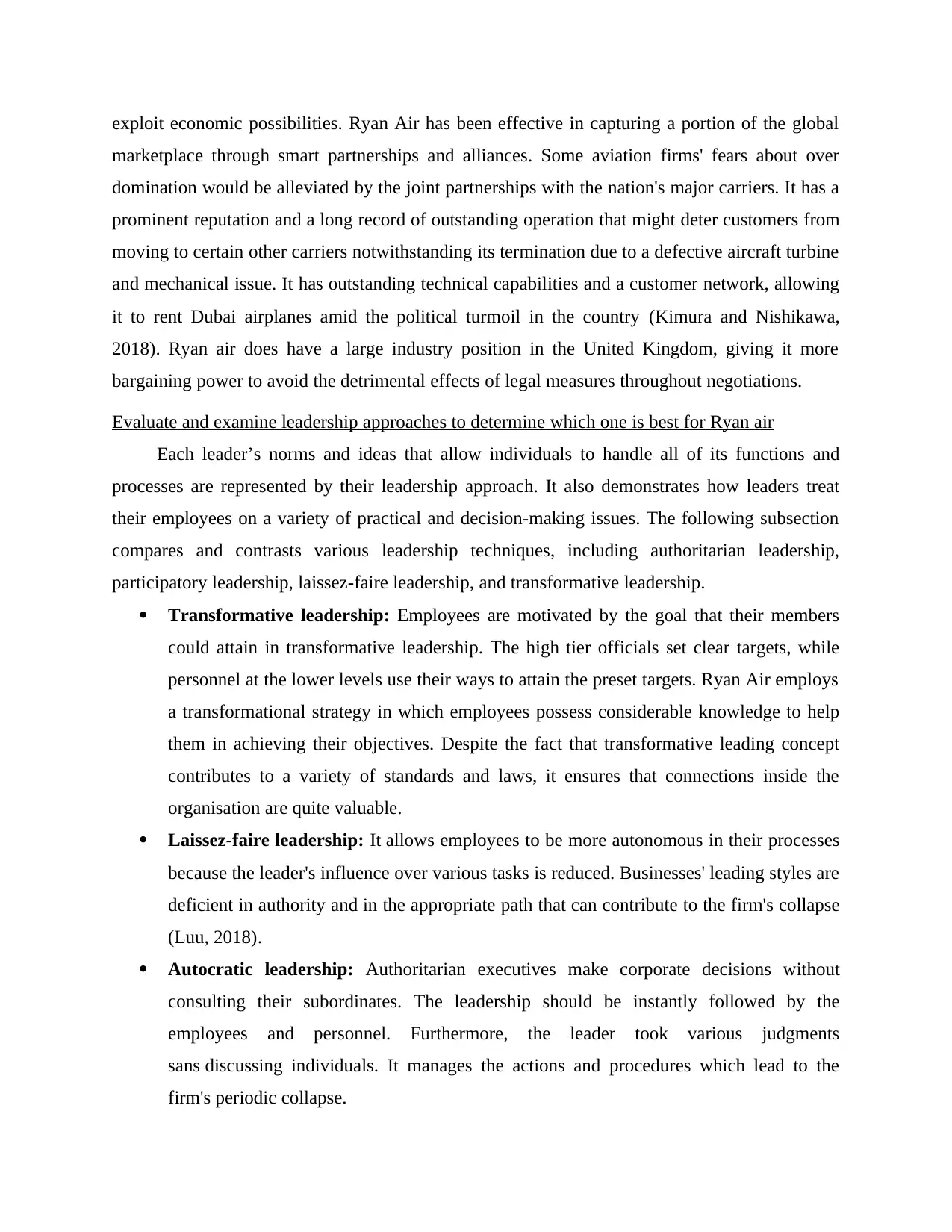
exploit economic possibilities. Ryan Air has been effective in capturing a portion of the global
marketplace through smart partnerships and alliances. Some aviation firms' fears about over
domination would be alleviated by the joint partnerships with the nation's major carriers. It has a
prominent reputation and a long record of outstanding operation that might deter customers from
moving to certain other carriers notwithstanding its termination due to a defective aircraft turbine
and mechanical issue. It has outstanding technical capabilities and a customer network, allowing
it to rent Dubai airplanes amid the political turmoil in the country (Kimura and Nishikawa,
2018). Ryan air does have a large industry position in the United Kingdom, giving it more
bargaining power to avoid the detrimental effects of legal measures throughout negotiations.
Evaluate and examine leadership approaches to determine which one is best for Ryan air
Each leader’s norms and ideas that allow individuals to handle all of its functions and
processes are represented by their leadership approach. It also demonstrates how leaders treat
their employees on a variety of practical and decision-making issues. The following subsection
compares and contrasts various leadership techniques, including authoritarian leadership,
participatory leadership, laissez-faire leadership, and transformative leadership.
Transformative leadership: Employees are motivated by the goal that their members
could attain in transformative leadership. The high tier officials set clear targets, while
personnel at the lower levels use their ways to attain the preset targets. Ryan Air employs
a transformational strategy in which employees possess considerable knowledge to help
them in achieving their objectives. Despite the fact that transformative leading concept
contributes to a variety of standards and laws, it ensures that connections inside the
organisation are quite valuable.
Laissez-faire leadership: It allows employees to be more autonomous in their processes
because the leader's influence over various tasks is reduced. Businesses' leading styles are
deficient in authority and in the appropriate path that can contribute to the firm's collapse
(Luu, 2018).
Autocratic leadership: Authoritarian executives make corporate decisions without
consulting their subordinates. The leadership should be instantly followed by the
employees and personnel. Furthermore, the leader took various judgments
sans discussing individuals. It manages the actions and procedures which lead to the
firm's periodic collapse.
marketplace through smart partnerships and alliances. Some aviation firms' fears about over
domination would be alleviated by the joint partnerships with the nation's major carriers. It has a
prominent reputation and a long record of outstanding operation that might deter customers from
moving to certain other carriers notwithstanding its termination due to a defective aircraft turbine
and mechanical issue. It has outstanding technical capabilities and a customer network, allowing
it to rent Dubai airplanes amid the political turmoil in the country (Kimura and Nishikawa,
2018). Ryan air does have a large industry position in the United Kingdom, giving it more
bargaining power to avoid the detrimental effects of legal measures throughout negotiations.
Evaluate and examine leadership approaches to determine which one is best for Ryan air
Each leader’s norms and ideas that allow individuals to handle all of its functions and
processes are represented by their leadership approach. It also demonstrates how leaders treat
their employees on a variety of practical and decision-making issues. The following subsection
compares and contrasts various leadership techniques, including authoritarian leadership,
participatory leadership, laissez-faire leadership, and transformative leadership.
Transformative leadership: Employees are motivated by the goal that their members
could attain in transformative leadership. The high tier officials set clear targets, while
personnel at the lower levels use their ways to attain the preset targets. Ryan Air employs
a transformational strategy in which employees possess considerable knowledge to help
them in achieving their objectives. Despite the fact that transformative leading concept
contributes to a variety of standards and laws, it ensures that connections inside the
organisation are quite valuable.
Laissez-faire leadership: It allows employees to be more autonomous in their processes
because the leader's influence over various tasks is reduced. Businesses' leading styles are
deficient in authority and in the appropriate path that can contribute to the firm's collapse
(Luu, 2018).
Autocratic leadership: Authoritarian executives make corporate decisions without
consulting their subordinates. The leadership should be instantly followed by the
employees and personnel. Furthermore, the leader took various judgments
sans discussing individuals. It manages the actions and procedures which lead to the
firm's periodic collapse.
Paraphrase This Document
Need a fresh take? Get an instant paraphrase of this document with our AI Paraphraser
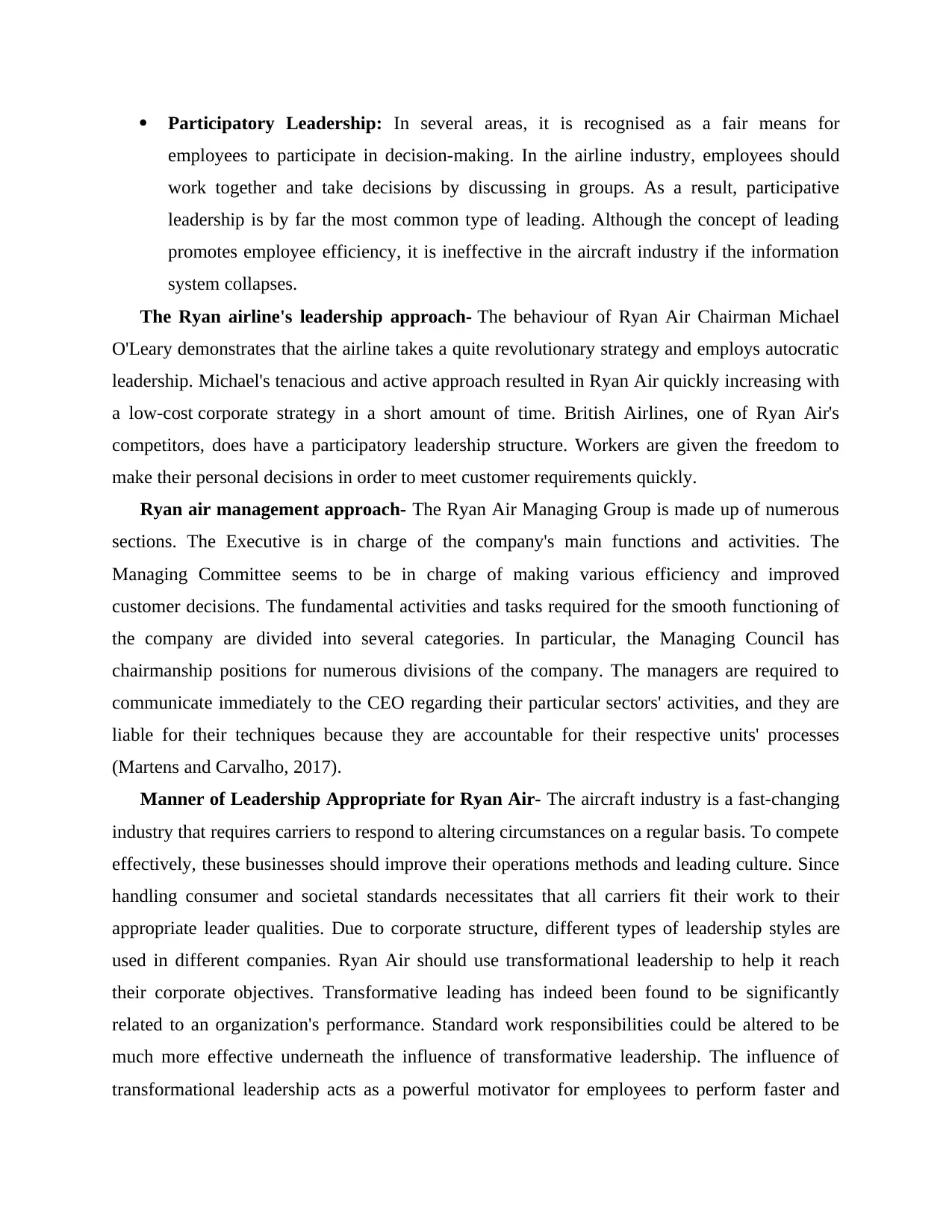
Participatory Leadership: In several areas, it is recognised as a fair means for
employees to participate in decision-making. In the airline industry, employees should
work together and take decisions by discussing in groups. As a result, participative
leadership is by far the most common type of leading. Although the concept of leading
promotes employee efficiency, it is ineffective in the aircraft industry if the information
system collapses.
The Ryan airline's leadership approach- The behaviour of Ryan Air Chairman Michael
O'Leary demonstrates that the airline takes a quite revolutionary strategy and employs autocratic
leadership. Michael's tenacious and active approach resulted in Ryan Air quickly increasing with
a low-cost corporate strategy in a short amount of time. British Airlines, one of Ryan Air's
competitors, does have a participatory leadership structure. Workers are given the freedom to
make their personal decisions in order to meet customer requirements quickly.
Ryan air management approach- The Ryan Air Managing Group is made up of numerous
sections. The Executive is in charge of the company's main functions and activities. The
Managing Committee seems to be in charge of making various efficiency and improved
customer decisions. The fundamental activities and tasks required for the smooth functioning of
the company are divided into several categories. In particular, the Managing Council has
chairmanship positions for numerous divisions of the company. The managers are required to
communicate immediately to the CEO regarding their particular sectors' activities, and they are
liable for their techniques because they are accountable for their respective units' processes
(Martens and Carvalho, 2017).
Manner of Leadership Appropriate for Ryan Air- The aircraft industry is a fast-changing
industry that requires carriers to respond to altering circumstances on a regular basis. To compete
effectively, these businesses should improve their operations methods and leading culture. Since
handling consumer and societal standards necessitates that all carriers fit their work to their
appropriate leader qualities. Due to corporate structure, different types of leadership styles are
used in different companies. Ryan Air should use transformational leadership to help it reach
their corporate objectives. Transformative leading has indeed been found to be significantly
related to an organization's performance. Standard work responsibilities could be altered to be
much more effective underneath the influence of transformative leadership. The influence of
transformational leadership acts as a powerful motivator for employees to perform faster and
employees to participate in decision-making. In the airline industry, employees should
work together and take decisions by discussing in groups. As a result, participative
leadership is by far the most common type of leading. Although the concept of leading
promotes employee efficiency, it is ineffective in the aircraft industry if the information
system collapses.
The Ryan airline's leadership approach- The behaviour of Ryan Air Chairman Michael
O'Leary demonstrates that the airline takes a quite revolutionary strategy and employs autocratic
leadership. Michael's tenacious and active approach resulted in Ryan Air quickly increasing with
a low-cost corporate strategy in a short amount of time. British Airlines, one of Ryan Air's
competitors, does have a participatory leadership structure. Workers are given the freedom to
make their personal decisions in order to meet customer requirements quickly.
Ryan air management approach- The Ryan Air Managing Group is made up of numerous
sections. The Executive is in charge of the company's main functions and activities. The
Managing Committee seems to be in charge of making various efficiency and improved
customer decisions. The fundamental activities and tasks required for the smooth functioning of
the company are divided into several categories. In particular, the Managing Council has
chairmanship positions for numerous divisions of the company. The managers are required to
communicate immediately to the CEO regarding their particular sectors' activities, and they are
liable for their techniques because they are accountable for their respective units' processes
(Martens and Carvalho, 2017).
Manner of Leadership Appropriate for Ryan Air- The aircraft industry is a fast-changing
industry that requires carriers to respond to altering circumstances on a regular basis. To compete
effectively, these businesses should improve their operations methods and leading culture. Since
handling consumer and societal standards necessitates that all carriers fit their work to their
appropriate leader qualities. Due to corporate structure, different types of leadership styles are
used in different companies. Ryan Air should use transformational leadership to help it reach
their corporate objectives. Transformative leading has indeed been found to be significantly
related to an organization's performance. Standard work responsibilities could be altered to be
much more effective underneath the influence of transformative leadership. The influence of
transformational leadership acts as a powerful motivator for employees to perform faster and
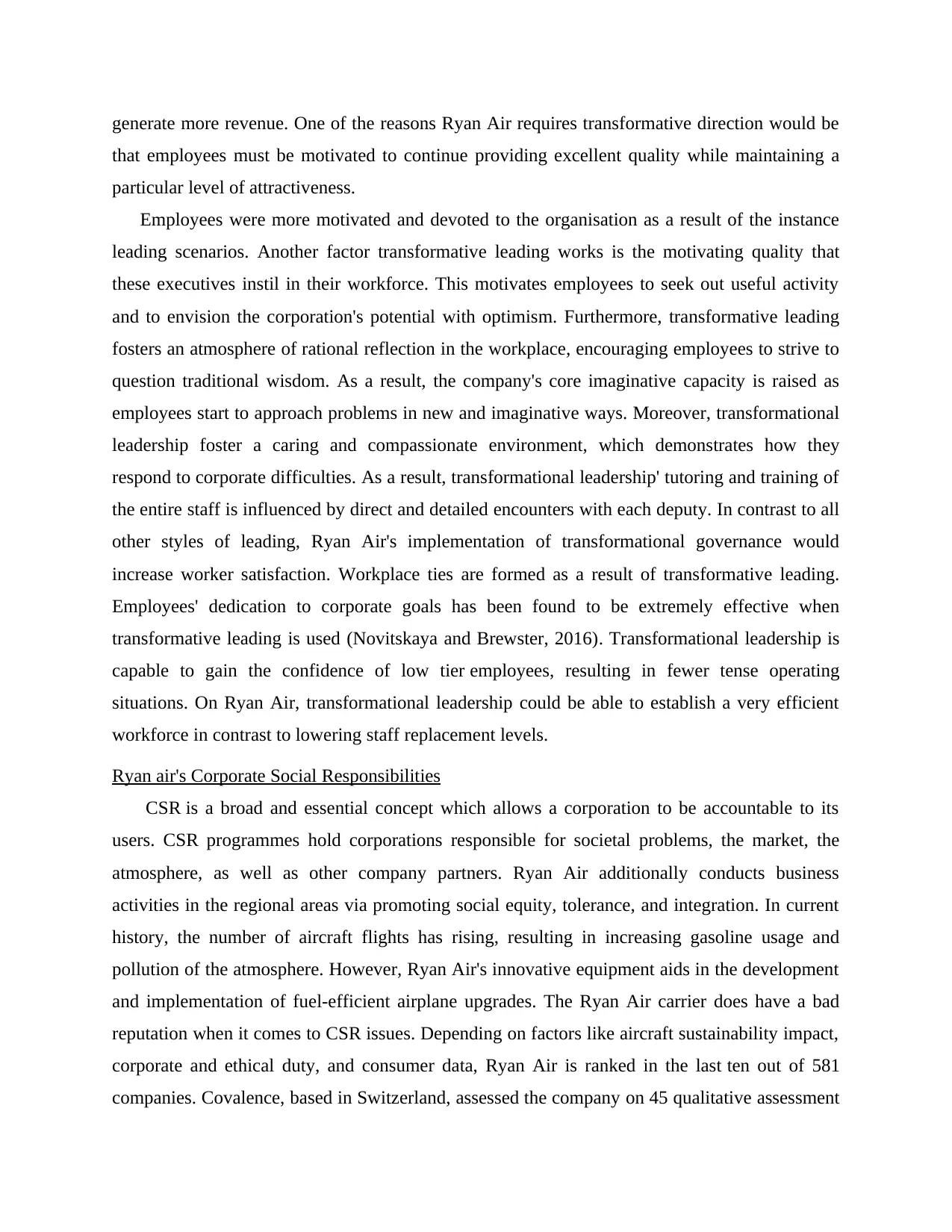
generate more revenue. One of the reasons Ryan Air requires transformative direction would be
that employees must be motivated to continue providing excellent quality while maintaining a
particular level of attractiveness.
Employees were more motivated and devoted to the organisation as a result of the instance
leading scenarios. Another factor transformative leading works is the motivating quality that
these executives instil in their workforce. This motivates employees to seek out useful activity
and to envision the corporation's potential with optimism. Furthermore, transformative leading
fosters an atmosphere of rational reflection in the workplace, encouraging employees to strive to
question traditional wisdom. As a result, the company's core imaginative capacity is raised as
employees start to approach problems in new and imaginative ways. Moreover, transformational
leadership foster a caring and compassionate environment, which demonstrates how they
respond to corporate difficulties. As a result, transformational leadership' tutoring and training of
the entire staff is influenced by direct and detailed encounters with each deputy. In contrast to all
other styles of leading, Ryan Air's implementation of transformational governance would
increase worker satisfaction. Workplace ties are formed as a result of transformative leading.
Employees' dedication to corporate goals has been found to be extremely effective when
transformative leading is used (Novitskaya and Brewster, 2016). Transformational leadership is
capable to gain the confidence of low tier employees, resulting in fewer tense operating
situations. On Ryan Air, transformational leadership could be able to establish a very efficient
workforce in contrast to lowering staff replacement levels.
Ryan air's Corporate Social Responsibilities
CSR is a broad and essential concept which allows a corporation to be accountable to its
users. CSR programmes hold corporations responsible for societal problems, the market, the
atmosphere, as well as other company partners. Ryan Air additionally conducts business
activities in the regional areas via promoting social equity, tolerance, and integration. In current
history, the number of aircraft flights has rising, resulting in increasing gasoline usage and
pollution of the atmosphere. However, Ryan Air's innovative equipment aids in the development
and implementation of fuel-efficient airplane upgrades. The Ryan Air carrier does have a bad
reputation when it comes to CSR issues. Depending on factors like aircraft sustainability impact,
corporate and ethical duty, and consumer data, Ryan Air is ranked in the last ten out of 581
companies. Covalence, based in Switzerland, assessed the company on 45 qualitative assessment
that employees must be motivated to continue providing excellent quality while maintaining a
particular level of attractiveness.
Employees were more motivated and devoted to the organisation as a result of the instance
leading scenarios. Another factor transformative leading works is the motivating quality that
these executives instil in their workforce. This motivates employees to seek out useful activity
and to envision the corporation's potential with optimism. Furthermore, transformative leading
fosters an atmosphere of rational reflection in the workplace, encouraging employees to strive to
question traditional wisdom. As a result, the company's core imaginative capacity is raised as
employees start to approach problems in new and imaginative ways. Moreover, transformational
leadership foster a caring and compassionate environment, which demonstrates how they
respond to corporate difficulties. As a result, transformational leadership' tutoring and training of
the entire staff is influenced by direct and detailed encounters with each deputy. In contrast to all
other styles of leading, Ryan Air's implementation of transformational governance would
increase worker satisfaction. Workplace ties are formed as a result of transformative leading.
Employees' dedication to corporate goals has been found to be extremely effective when
transformative leading is used (Novitskaya and Brewster, 2016). Transformational leadership is
capable to gain the confidence of low tier employees, resulting in fewer tense operating
situations. On Ryan Air, transformational leadership could be able to establish a very efficient
workforce in contrast to lowering staff replacement levels.
Ryan air's Corporate Social Responsibilities
CSR is a broad and essential concept which allows a corporation to be accountable to its
users. CSR programmes hold corporations responsible for societal problems, the market, the
atmosphere, as well as other company partners. Ryan Air additionally conducts business
activities in the regional areas via promoting social equity, tolerance, and integration. In current
history, the number of aircraft flights has rising, resulting in increasing gasoline usage and
pollution of the atmosphere. However, Ryan Air's innovative equipment aids in the development
and implementation of fuel-efficient airplane upgrades. The Ryan Air carrier does have a bad
reputation when it comes to CSR issues. Depending on factors like aircraft sustainability impact,
corporate and ethical duty, and consumer data, Ryan Air is ranked in the last ten out of 581
companies. Covalence, based in Switzerland, assessed the company on 45 qualitative assessment
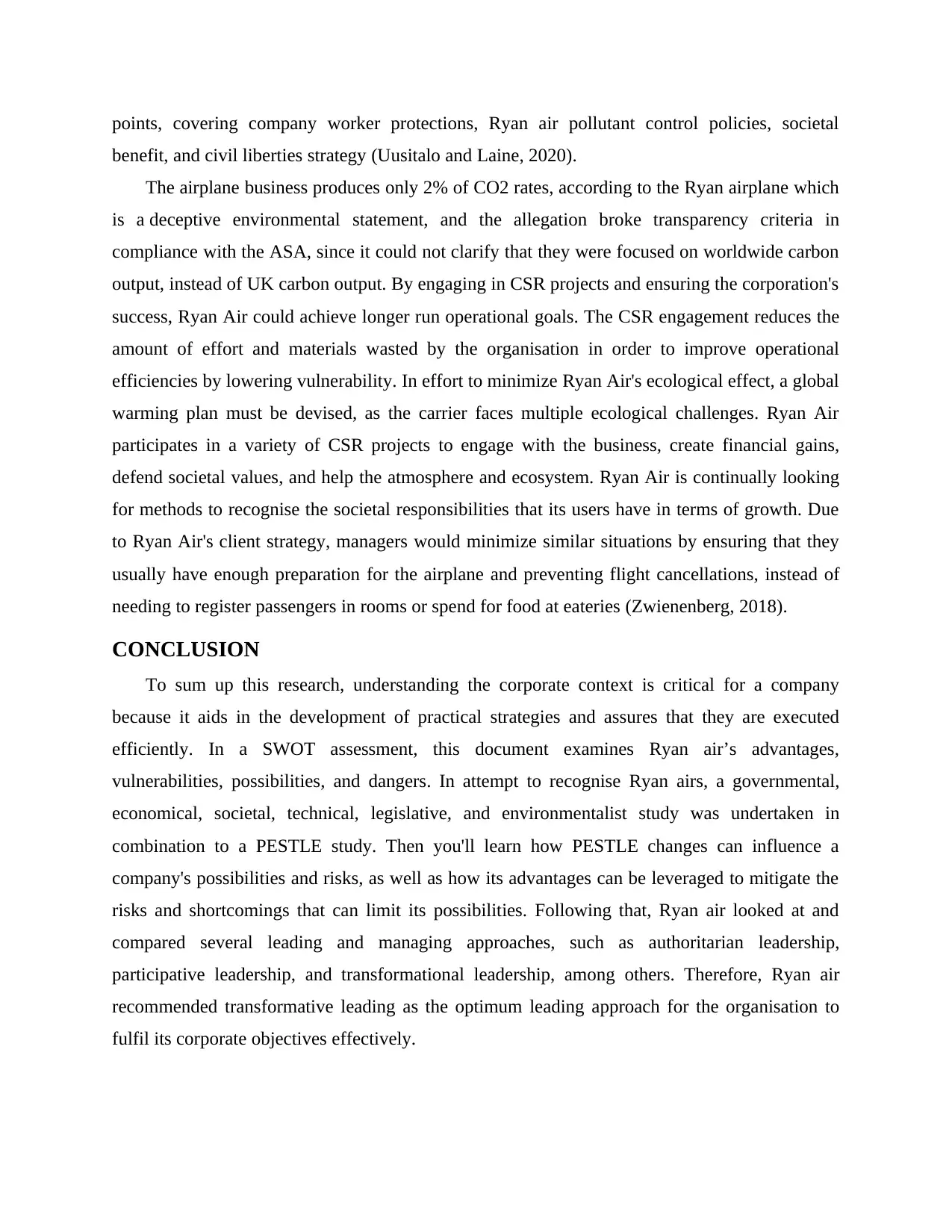
points, covering company worker protections, Ryan air pollutant control policies, societal
benefit, and civil liberties strategy (Uusitalo and Laine, 2020).
The airplane business produces only 2% of CO2 rates, according to the Ryan airplane which
is a deceptive environmental statement, and the allegation broke transparency criteria in
compliance with the ASA, since it could not clarify that they were focused on worldwide carbon
output, instead of UK carbon output. By engaging in CSR projects and ensuring the corporation's
success, Ryan Air could achieve longer run operational goals. The CSR engagement reduces the
amount of effort and materials wasted by the organisation in order to improve operational
efficiencies by lowering vulnerability. In effort to minimize Ryan Air's ecological effect, a global
warming plan must be devised, as the carrier faces multiple ecological challenges. Ryan Air
participates in a variety of CSR projects to engage with the business, create financial gains,
defend societal values, and help the atmosphere and ecosystem. Ryan Air is continually looking
for methods to recognise the societal responsibilities that its users have in terms of growth. Due
to Ryan Air's client strategy, managers would minimize similar situations by ensuring that they
usually have enough preparation for the airplane and preventing flight cancellations, instead of
needing to register passengers in rooms or spend for food at eateries (Zwienenberg, 2018).
CONCLUSION
To sum up this research, understanding the corporate context is critical for a company
because it aids in the development of practical strategies and assures that they are executed
efficiently. In a SWOT assessment, this document examines Ryan air’s advantages,
vulnerabilities, possibilities, and dangers. In attempt to recognise Ryan airs, a governmental,
economical, societal, technical, legislative, and environmentalist study was undertaken in
combination to a PESTLE study. Then you'll learn how PESTLE changes can influence a
company's possibilities and risks, as well as how its advantages can be leveraged to mitigate the
risks and shortcomings that can limit its possibilities. Following that, Ryan air looked at and
compared several leading and managing approaches, such as authoritarian leadership,
participative leadership, and transformational leadership, among others. Therefore, Ryan air
recommended transformative leading as the optimum leading approach for the organisation to
fulfil its corporate objectives effectively.
benefit, and civil liberties strategy (Uusitalo and Laine, 2020).
The airplane business produces only 2% of CO2 rates, according to the Ryan airplane which
is a deceptive environmental statement, and the allegation broke transparency criteria in
compliance with the ASA, since it could not clarify that they were focused on worldwide carbon
output, instead of UK carbon output. By engaging in CSR projects and ensuring the corporation's
success, Ryan Air could achieve longer run operational goals. The CSR engagement reduces the
amount of effort and materials wasted by the organisation in order to improve operational
efficiencies by lowering vulnerability. In effort to minimize Ryan Air's ecological effect, a global
warming plan must be devised, as the carrier faces multiple ecological challenges. Ryan Air
participates in a variety of CSR projects to engage with the business, create financial gains,
defend societal values, and help the atmosphere and ecosystem. Ryan Air is continually looking
for methods to recognise the societal responsibilities that its users have in terms of growth. Due
to Ryan Air's client strategy, managers would minimize similar situations by ensuring that they
usually have enough preparation for the airplane and preventing flight cancellations, instead of
needing to register passengers in rooms or spend for food at eateries (Zwienenberg, 2018).
CONCLUSION
To sum up this research, understanding the corporate context is critical for a company
because it aids in the development of practical strategies and assures that they are executed
efficiently. In a SWOT assessment, this document examines Ryan air’s advantages,
vulnerabilities, possibilities, and dangers. In attempt to recognise Ryan airs, a governmental,
economical, societal, technical, legislative, and environmentalist study was undertaken in
combination to a PESTLE study. Then you'll learn how PESTLE changes can influence a
company's possibilities and risks, as well as how its advantages can be leveraged to mitigate the
risks and shortcomings that can limit its possibilities. Following that, Ryan air looked at and
compared several leading and managing approaches, such as authoritarian leadership,
participative leadership, and transformational leadership, among others. Therefore, Ryan air
recommended transformative leading as the optimum leading approach for the organisation to
fulfil its corporate objectives effectively.
Secure Best Marks with AI Grader
Need help grading? Try our AI Grader for instant feedback on your assignments.
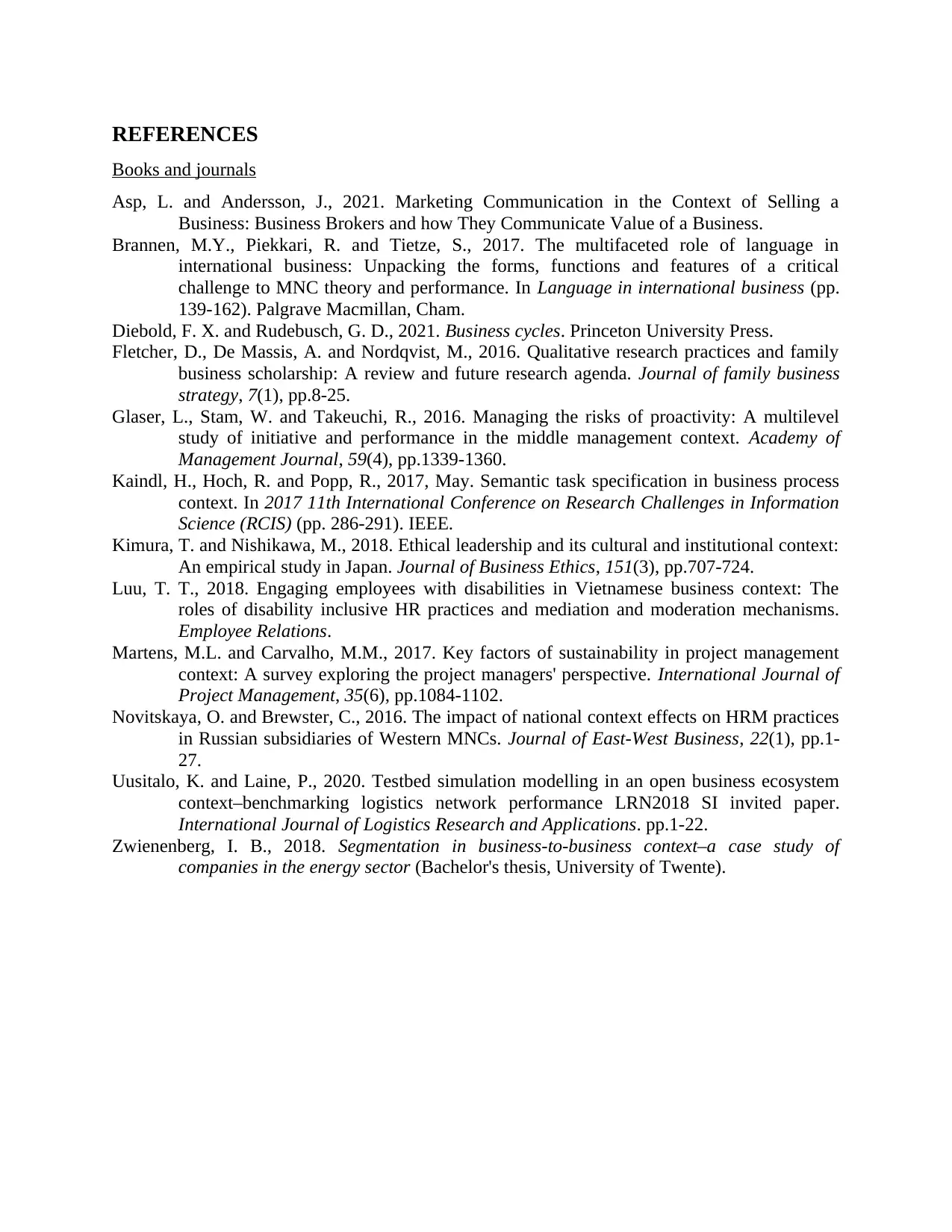
REFERENCES
Books and journals
Asp, L. and Andersson, J., 2021. Marketing Communication in the Context of Selling a
Business: Business Brokers and how They Communicate Value of a Business.
Brannen, M.Y., Piekkari, R. and Tietze, S., 2017. The multifaceted role of language in
international business: Unpacking the forms, functions and features of a critical
challenge to MNC theory and performance. In Language in international business (pp.
139-162). Palgrave Macmillan, Cham.
Diebold, F. X. and Rudebusch, G. D., 2021. Business cycles. Princeton University Press.
Fletcher, D., De Massis, A. and Nordqvist, M., 2016. Qualitative research practices and family
business scholarship: A review and future research agenda. Journal of family business
strategy, 7(1), pp.8-25.
Glaser, L., Stam, W. and Takeuchi, R., 2016. Managing the risks of proactivity: A multilevel
study of initiative and performance in the middle management context. Academy of
Management Journal, 59(4), pp.1339-1360.
Kaindl, H., Hoch, R. and Popp, R., 2017, May. Semantic task specification in business process
context. In 2017 11th International Conference on Research Challenges in Information
Science (RCIS) (pp. 286-291). IEEE.
Kimura, T. and Nishikawa, M., 2018. Ethical leadership and its cultural and institutional context:
An empirical study in Japan. Journal of Business Ethics, 151(3), pp.707-724.
Luu, T. T., 2018. Engaging employees with disabilities in Vietnamese business context: The
roles of disability inclusive HR practices and mediation and moderation mechanisms.
Employee Relations.
Martens, M.L. and Carvalho, M.M., 2017. Key factors of sustainability in project management
context: A survey exploring the project managers' perspective. International Journal of
Project Management, 35(6), pp.1084-1102.
Novitskaya, O. and Brewster, C., 2016. The impact of national context effects on HRM practices
in Russian subsidiaries of Western MNCs. Journal of East-West Business, 22(1), pp.1-
27.
Uusitalo, K. and Laine, P., 2020. Testbed simulation modelling in an open business ecosystem
context–benchmarking logistics network performance LRN2018 SI invited paper.
International Journal of Logistics Research and Applications. pp.1-22.
Zwienenberg, I. B., 2018. Segmentation in business-to-business context–a case study of
companies in the energy sector (Bachelor's thesis, University of Twente).
Books and journals
Asp, L. and Andersson, J., 2021. Marketing Communication in the Context of Selling a
Business: Business Brokers and how They Communicate Value of a Business.
Brannen, M.Y., Piekkari, R. and Tietze, S., 2017. The multifaceted role of language in
international business: Unpacking the forms, functions and features of a critical
challenge to MNC theory and performance. In Language in international business (pp.
139-162). Palgrave Macmillan, Cham.
Diebold, F. X. and Rudebusch, G. D., 2021. Business cycles. Princeton University Press.
Fletcher, D., De Massis, A. and Nordqvist, M., 2016. Qualitative research practices and family
business scholarship: A review and future research agenda. Journal of family business
strategy, 7(1), pp.8-25.
Glaser, L., Stam, W. and Takeuchi, R., 2016. Managing the risks of proactivity: A multilevel
study of initiative and performance in the middle management context. Academy of
Management Journal, 59(4), pp.1339-1360.
Kaindl, H., Hoch, R. and Popp, R., 2017, May. Semantic task specification in business process
context. In 2017 11th International Conference on Research Challenges in Information
Science (RCIS) (pp. 286-291). IEEE.
Kimura, T. and Nishikawa, M., 2018. Ethical leadership and its cultural and institutional context:
An empirical study in Japan. Journal of Business Ethics, 151(3), pp.707-724.
Luu, T. T., 2018. Engaging employees with disabilities in Vietnamese business context: The
roles of disability inclusive HR practices and mediation and moderation mechanisms.
Employee Relations.
Martens, M.L. and Carvalho, M.M., 2017. Key factors of sustainability in project management
context: A survey exploring the project managers' perspective. International Journal of
Project Management, 35(6), pp.1084-1102.
Novitskaya, O. and Brewster, C., 2016. The impact of national context effects on HRM practices
in Russian subsidiaries of Western MNCs. Journal of East-West Business, 22(1), pp.1-
27.
Uusitalo, K. and Laine, P., 2020. Testbed simulation modelling in an open business ecosystem
context–benchmarking logistics network performance LRN2018 SI invited paper.
International Journal of Logistics Research and Applications. pp.1-22.
Zwienenberg, I. B., 2018. Segmentation in business-to-business context–a case study of
companies in the energy sector (Bachelor's thesis, University of Twente).
1 out of 11
Related Documents
Your All-in-One AI-Powered Toolkit for Academic Success.
+13062052269
info@desklib.com
Available 24*7 on WhatsApp / Email
![[object Object]](/_next/static/media/star-bottom.7253800d.svg)
Unlock your academic potential
© 2024 | Zucol Services PVT LTD | All rights reserved.




